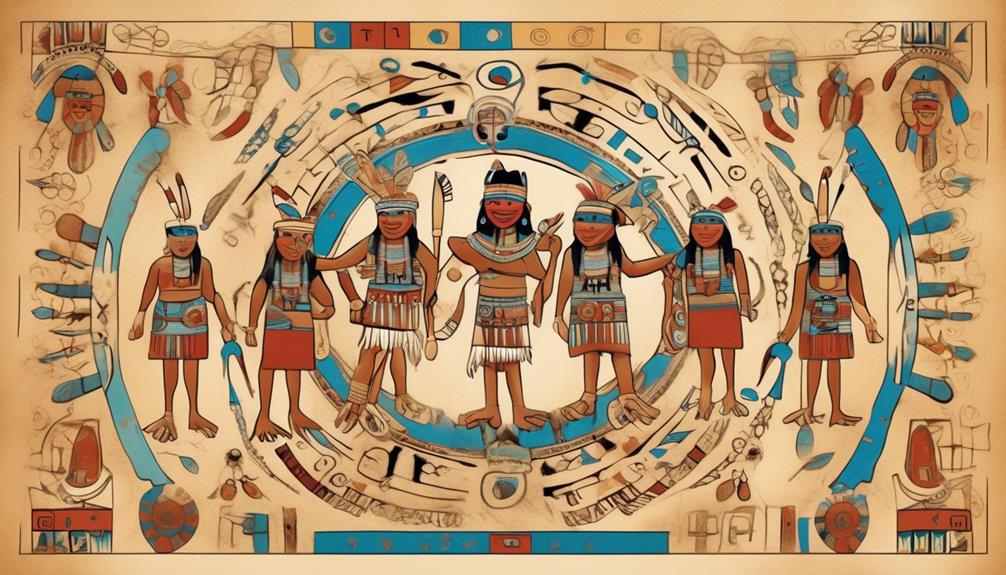Have you ever wondered what kind of clothing the Hopi Indian tribe traditionally wore to express their cultural identity?
The clothing of the Hopi people is not just about practicality, but it also holds deep cultural and spiritual significance.
From the traditional attire to the materials used and the evolution of their fashion, the Hopi clothing reflects a rich tapestry of history and tradition.
Let's explore the intricate details of the clothing and accessories that played a vital role in the daily lives of the Hopi tribe, offering insight into their customs and beliefs.
Key Takeaways
- Hopi clothing reflects deep cultural and spiritual connections.
- Symbols and patterns in Hopi attire convey cultural narratives and spiritual significance.
- Hopi garments are crafted with attention to detail and enduring traditions, using materials such as cotton textiles and animal hides.
- Hopi fashion has evolved by preserving tradition while incorporating modern fabrics, colors, and motifs.
Traditional Hopi Clothing
Traditionally, Hopi clothing reflects the tribe's deep cultural and spiritual connections, incorporating intricate designs and meaningful symbolism. Hopi attire isn't just a form of dress but a representation of their rich cultural heritage and spiritual beliefs.
The clothing worn by the Hopi people holds immense cultural significance as it's intertwined with their ceremonial practices and daily life. The traditional attire of the Hopi is adorned with symbols and patterns that convey stories of their origin, their relationship with nature, and their religious ceremonies. Each garment is meticulously crafted, with every design serving a specific purpose and carrying deep cultural meaning.
The colors used in the attire also hold significance, representing elements such as the earth, sky, and sun, which are central to the Hopi belief system. The intricate details and craftsmanship of their clothing showcase the importance of tradition and spirituality within the Hopi community, emphasizing the cultural continuity and resilience of their heritage.
Symbolism in Hopi Attire

Symbolic motifs and intricate patterns play a central role in the design of Hopi attire, conveying profound cultural narratives and spiritual significance. Each symbol woven into the fabric or adorned on the clothing holds deep cultural significance, reflecting the tribe's connection to their ancestors, the natural world, and the spiritual realm. The use of specific colors, such as black to represent the north and yellow for the west, holds symbolic meaning tied to the cardinal directions and the journey of life. Additionally, geometric patterns like diamonds, squares, and lines often seen in Hopi attire symbolize elements of the natural world, such as rain, clouds, and the earth.
Beyond their aesthetic appeal, these symbols serve as a form of visual storytelling, preserving the tribe's history, traditions, and spiritual beliefs. For instance, the depiction of katsinas, supernatural beings central to Hopi religious practices, on garments not only showcases the tribe's artistic prowess but also reinforces their deep spiritual connection to the katsina spirits.
Thus, Hopi attire isn't merely clothing but a profound expression of the tribe's cultural identity and spiritual beliefs, carrying the weight of centuries of tradition and symbolism.
Materials Used in Hopi Garments
The Hopi people meticulously select and utilize a diverse array of natural materials in crafting their traditional garments, each chosen for its symbolic and practical significance.
Cotton textiles are a fundamental component of Hopi clothing. The cultivation of cotton has been a long-standing tradition within the tribe, and the material holds deep cultural meaning. Cotton is used in the creation of traditional Hopi shirts, dresses, and sashes, with intricate patterns often woven into the fabric.
Additionally, animal hides play a crucial role in Hopi attire. The hides of deer, elk, and sheep are skillfully tanned and fashioned into various garments such as moccasins, headdresses, and ceremonial attire. The use of animal hides not only provides durability and protection from the elements but also holds spiritual significance, connecting the wearer to the natural world and the animals that sustain their community.
The combination of these materials reflects the Hopi people's deep connection to their environment and the enduring traditions that continue to shape their cultural identity.
Evolution of Hopi Fashion

Crafting their traditional garments with meticulous attention to detail and an unwavering connection to natural materials, the Hopi people have witnessed a fascinating evolution in their fashion over time. The evolution of Hopi fashion has been influenced by modern trends and cultural shifts, resulting in a blend of traditional and contemporary elements.
- Preservation of Tradition: Despite modern influences, the Hopi people continue to honor their cultural heritage by preserving traditional designs and techniques in their garments.
- Incorporation of Modern Fabrics: In recent years, modern fabrics such as cotton and synthetic materials have been integrated into Hopi fashion, offering durability and versatility.
- Fusion of Styles: The evolution of Hopi fashion has led to a fusion of traditional Hopi attire with modern silhouettes and designs, reflecting a balance between heritage and contemporary aesthetics.
- Embracing Color and Patterns: While traditional Hopi garments were characterized by earthy tones and symbolic patterns, modern influences have seen a broader spectrum of colors and diverse motifs being embraced.
- Adaptation to Lifestyle Changes: As the lifestyle of the Hopi people has evolved, so has their fashion, with garments being adapted to meet the practical needs of modern daily life while still maintaining cultural significance.
Significance of Hopi Accessories
Exploring the role of accessories within Hopi culture reveals their deep significance in conveying social, spiritual, and artistic aspects of the community's heritage.
Hopi accessories such as jewelry, pottery, and textiles hold immense cultural significance, often representing the tribe's rich history, traditions, and beliefs. Each accessory is meticulously crafted, serving as a form of artistic expression that reflects the Hopi people's reverence for their land, animals, and spiritual deities.
For instance, intricate designs etched into silver jewelry often depict important symbols like the sun, rain, and corn, all of which hold profound spiritual meaning for the Hopi. These accessories aren't merely ornamental but are deeply intertwined with ceremonial and everyday life, serving as tangible expressions of the tribe's cultural identity.
The use of specific materials and techniques in creating these accessories also signifies the Hopi people's connection to their ancestors and the natural world, further underlining the cultural significance of these items.
Through their accessories, the Hopi tribe continues to preserve and perpetuate their traditions, communicating their values and history through the artistry of their craftsmanship.
Frequently Asked Questions
How Did the Hopi Indian Tribe Learn to Make Their Traditional Clothing and Accessories?
We learned about the Hopi Indian tribe's learning process in making their traditional clothing and accessories. They acquired these skills through a combination of observation, practice, and mentorship within their community.
The Hopi people utilized traditional techniques passed down through generations, such as weaving, embroidery, and dyeing, to create their distinctive attire and adornments.
This process reflects the tribe's deep connection to their cultural heritage and the preservation of their artistic traditions.
Are There Any Specific Rituals or Ceremonies Associated With the Creation or Wearing of Hopi Attire?
Ritual significance and cultural significance play a significant role in the creation and wearing of Hopi attire.
The Hopi people attach deep spiritual meaning to their traditional clothing, often incorporating specific designs and symbols that hold ceremonial importance.
Additionally, the act of crafting and donning these garments is tied to various rituals and ceremonies that honor their heritage and connect them to their ancestors.
Such practices are integral to preserving the Hopi cultural identity.
What Role Did Natural Resources Play in the Production of Hopi Garments and Accessories?
Natural resources played a crucial role in the production of Hopi garments and accessories. The environment provided materials like cotton, wool, and plant dyes, which were integral to traditional craftsmanship. These resources were carefully harvested and processed, reflecting the deep connection between the Hopi people and their surroundings.
This sustainable approach not only ensured the authenticity of the attire but also honored the spiritual significance of nature in their culture.
How Has Contact With Other Cultures Influenced the Evolution of Hopi Fashion Over Time?
Cultural influences have had a significant impact on the evolution of Hopi fashion over time. Through interactions with other tribes and later with European settlers, the Hopi people incorporated new materials, designs, and techniques into their traditional garments.
This cultural exchange resulted in the adaptation of new styles, such as the introduction of woven cloth and the incorporation of trade beads and metal ornaments, reflecting a blend of traditional and outside influences in Hopi fashion evolution.
Are There Any Specific Taboos or Restrictions Related to the Wearing of Certain Hopi Attire or Accessories?
We're mindful of specific taboos and restrictions related to the wearing of certain Hopi attire or accessories. These cultural guidelines are deeply rooted in the significance of traditional techniques and hold immense importance within the tribe.
The attire and accessories carry deep spiritual and symbolic meanings, and it's essential to respect and uphold these traditions. Understanding and adhering to these customs is integral to preserving the rich heritage of the Hopi tribe.
Conclusion
In conclusion, the traditional clothing of the Hopi Indian tribe reflects their rich cultural heritage and spiritual beliefs.
The intricate designs and use of natural materials in their garments symbolize their deep connection to the earth and their ancestors.
As the Hopi people continue to preserve and pass down their traditional fashion, they carry on the legacy of their ancestors and keep their culture alive for future generations to appreciate and learn from.
Mary is a passionate writer who brings creativity and a fresh perspective to our team. Her words have the power to captivate and inspire, making her an essential contributor to our content. Mary’s commitment to storytelling and dedication to promoting Indigenous culture ensures that her work touches the hearts of our readers. We’re fortunate to have her as part of our team.










